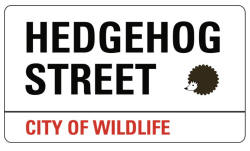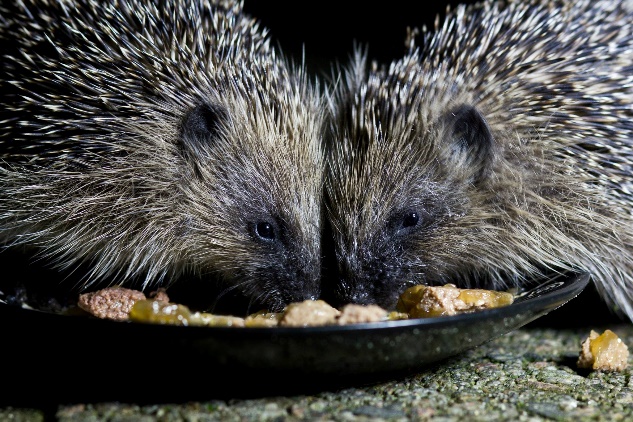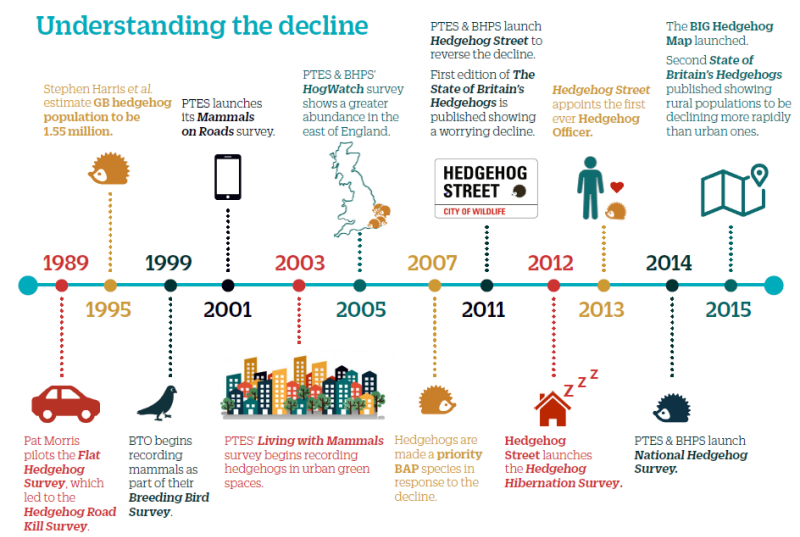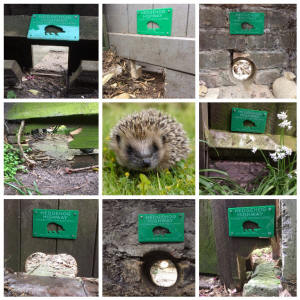The changing habitats of hedgehogs

How the human landscape has influenced hedgehog habitats in the UK
Grace Johnson, Hedgehog Officer

Hedgehogs are a generalist species, not just in their feeding habits but also their choice of habitats. Our only native UK species, the west European hedgehog (Erinaceus europaeus) can thrive in both urban and rural environments. As the name suggests, hedgehogs are often found in and around hedgerows, but other habitats include farming pastures, woodland edges and more increasingly in gardens. The only places a hedgehog wouldn’t be found in the UK are some islands, and upland areas such as mountainsides. It would be easy to think that an animal as opportunistic as this would be thriving in the wild, but unfortunately this isn’t the case. It was estimated that the UK hosted 36.5 million hedgehogs in the 1950s but as a result of development and expansion of the built environment, hedgehog numbers have dropped. Whilst they’re not an easy species to survey, the evidence we do have tells us that numbers are declining rapidly. By 1995 the estimate was revised down to 1.5 million.
The State of Britain’s Hedgehogs 2018, published by People’s
Trust for Endangered Species and the British Hedgehog Preservation
Society, reviews the distribution and abundance of hedgehogs in urban
and rural habitats. The report states that rural hedgehogs declined
between 2002 and 2017. PTES’ Mammals on Roads survey, suggests
that hedgehogs in rural locations are under a higher threat of road
fatality, as a result of higher speed limits and reduced lighting.
Agricultural intensification resulting in habitat loss and fragmentation
in the rural environment has also contributed to the decline in hedgehog
numbers. There is also a higher incidence of badgers in rural areas,
which are the main predator of hedgehogs in the UK. However, the fact
that badgers and hedgehogs co-exist in many areas indicates that we need
a better understanding of the habitat features that support both. When
environmental factors and subsequent food availability are favourable,
badger predation appears to be less of a threat to hedgehogs.

Data from urban hedgehog populations however, shows a slightly different picture. The distribution of urban populations has reduced in the last 15 years, however more recently abundance in some locations has increased. Along with many other UK mammal species, such as foxes and grey squirrels, hedgehogs increasingly make use of our towns and cities. Whilst the term ‘urban environment’ is synonymous with skyscrapers and developments, it also encapsulates the suburbs and urban parks found in and around settlements.

Gardens are becoming increasingly important for hedgehogs and other species whose natural habitats are under threat. Gardens provide shelter and food and, increasingly, a hedgehog house and supplementary food from a homeowner. Hedgehogs frequently top the polls of Britain’s favourite animal, so homeowners are often keen to help their local hedgehogs. But there are drawbacks as well. Gardens, by their very nature are divided by fences and walls, thus limiting a hedgehog’s territory. Hedgehogs roam far and wide to find suitable shelter and food, and can travel an average of 2 km in a single night, which means they need a lot of gardens. Simple actions such as creating gaps in fences to make ‘hedgehog highways’, connects gardens and allows hedgehogs to easily travel as far as they need to find food and mates. As well as installing hedgehog highways, homeowners can also help their visitors by leaving supplementary food out (meaty cat or dog food), making a ‘wild corner’ in the garden to provide shelter and encourage invertebrates, and being vigilant when building bonfires and strimming. Pre-prepared bonfires are unfortunately ideal habitat for hedgehogs around the 5th November, when they are searching for hibernacula. Accidents can be avoided by checking the bonfire very carefully before lighting, placing a wire fence around the outside, or alternatively building it or moving it at the last moment, to prevent any hedgehogs from taking up residence. Additionally, a thorough check of garden areas to be strimmed, as well as an initial cut to around 10cm, can prevent fatal injuries to any hidden hedgehogs.
With increasing public awareness and knowledge of hedgehogs, gardens have the potential to become a stronghold for our remaining hedgehogs. With this in mind, Hedgehog Street was set up in 2011 by People’s Trust for Endangered Species and the British Hedgehog Preservation Society. One of the main aims is to encourage people to make their gardens more hedgehog friendly through wildlife gardening, hedgehog holes and highways. Nearly 70,000 people have registered as ‘hedgehog champions’ since the campaign began. Hedgehog Street also offers ecology and habitat training for land managers, liaises with developers to increase connectivity in new developments, funds hedgehog research and carries out engagement and outreach work. For more information about the project, please visit hedgehogstreet.org.
Updated information October 2021:
Over 100,000 people have now registered as ‘hedgehog champions’
Updated information December 2022:
A new State of Britain’s Hedgehogs report was published in 2022, which found differences between urban and rural populations to be increasingly apparent. In urban areas, the picture is of a stable population showing early signs of recovery. This highlights the importance of gardens and green spaces, as well as local action by Hedgehog Champions. In stark contrast, rural populations remain low. In the last two decades, numbers have continued to decline by between a third and three-quarters nationally. The largest declines are seen in the eastern half of England. The full report can be found here.